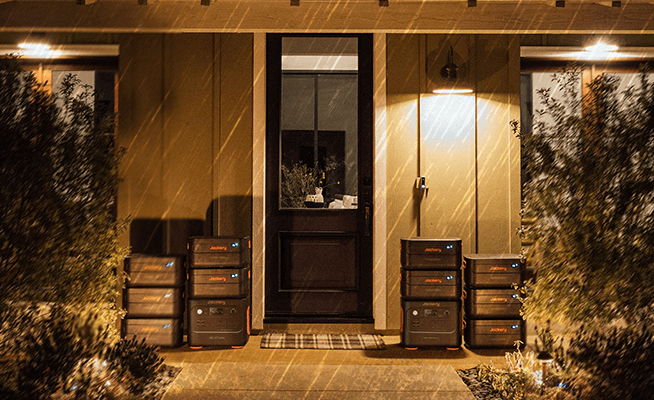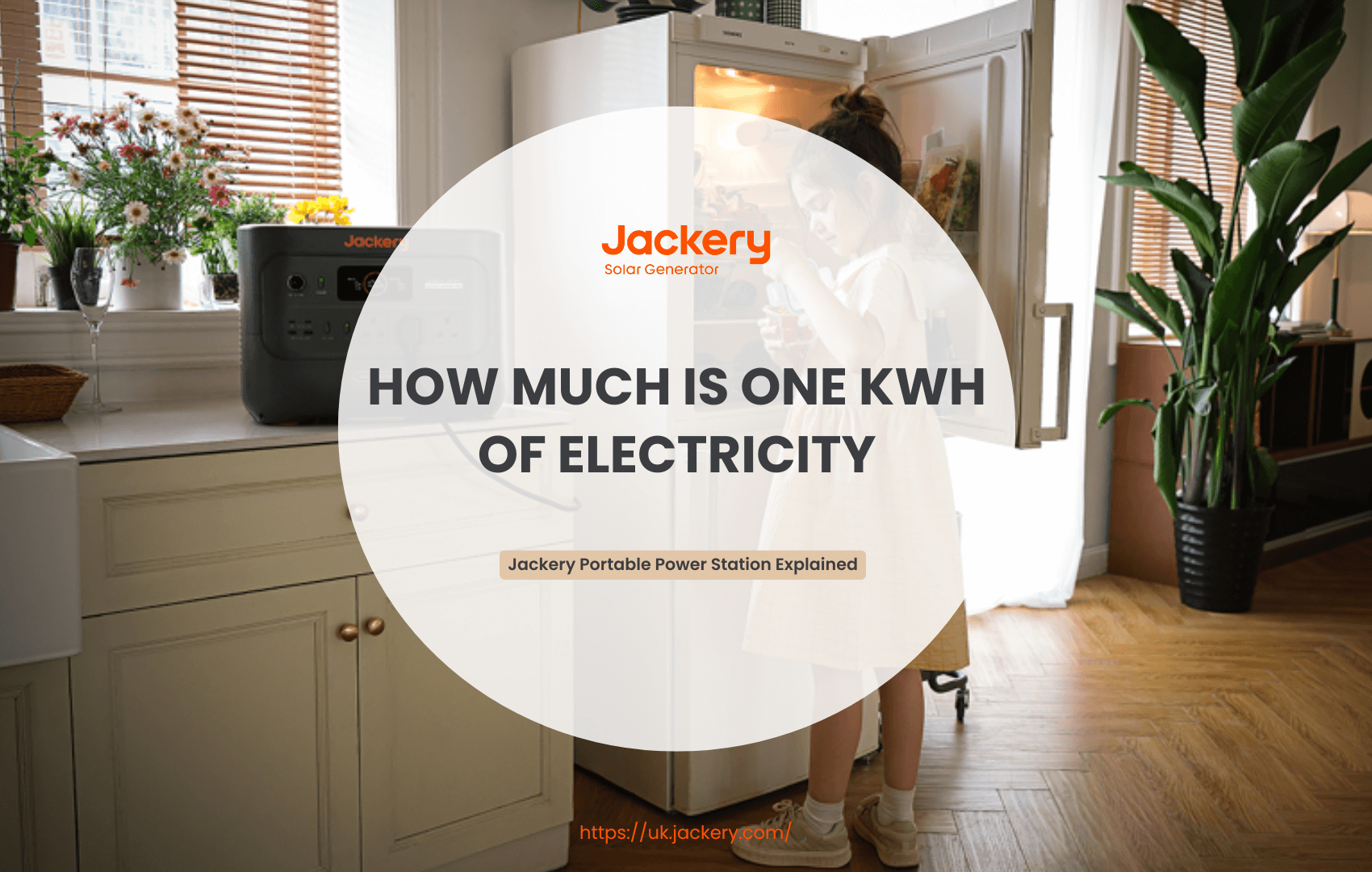In the UK, electricity charges are usually based on the number of kilowatt-hours you consume. So, how much is one kwh of electricity? According to the energy price cap released by Ofgem, the price of 1 kWh of electricity will be £ 27.03 from April 1 to June 30, 2025.
However, the UK energy market is quite complex so that electricity prices can fluctuate depending on various factors. Influencing factors include geographical location, the method of energy delivery to your home, and the profit margin suppliers aim to achieve.
In this blog, you can not only learn about the price of one kWh of electricity, the factors that affect it, and future trends, but also master some practical ways to deal with expensive electricity prices. We also offer some advice on saving on your electric bills, including choosing a Jackery Portable Power Station to power your appliances with solar energy or off-peak electricity, effectively reducing your bills.
|
Key Takeaways: |
|
● One kWh represents the energy consumed by an appliance with a power of 1 kilowatt for 1 hour. ● The price of one kWh of electricity is composed of wholesale costs, network costs, environmental & social obligation costs, and supplier operating costs. ● From April 1 to June 30, 2025, the price of 1 kWh of electricity is £ 0.27. ● The cost of power generation, transmission, and distribution, as well as market mechanisms, weather conditions, and government policies, typically influence the price of electricity per kilowatt-hour (kWh). ● In the long run, the trend of electricity prices in the UK is influenced by the energy transition goals and the shift towards a low-carbon and flexible power supply system. ● Suppose the price of electricity per kWh is too high. In that case, you can optimise your electricity habits, switch to a cheaper energy supplier, consider renewable energy or apply for government subsidies and assistance. ● We highly recommend the Jackery Explorer 2000 v2 or 3000 v2 portable power station as a reliable portable power source for your home backup or to help reduce your electricity bills. |
What Is One kWh of Electricity?
The kilowatt-hour (kWh) is a standard unit for measuring the consumption and supply of electrical energy. It is widely used in electricity metering across various sectors, including residential, industrial, and commercial applications. One kilowatt-hour represents the energy consumed by an appliance with a power of 1 kilowatt (kW) over a period of 1 hour.
But if its power is increased to 2000 watts, 1 kilowatt-hour can be consumed in half an hour. For example, 1 kilowatt-hour is equivalent to the electricity consumed by a 100-watt light bulb that is lit continuously for 10 hours or the electricity consumed by a 2000-watt air conditioner that runs for 0.5 hours (30 minutes).
What Can One kWh of Electricity Be Used for?
1 kilowatt-hour of electricity can support the use of various appliances for a certain amount of time, depending on the appliance's power consumption. For example:
|
Electrical Appliances |
Power (Watts) |
Time to Consume 1 kWh (hours) |
|
LED bulbs |
10 |
100 |
|
Electric fans |
50 |
20 |
|
TV sets |
100 |
10 |
|
Refrigerators |
150 |
About 6.7 |
|
Microwave ovens |
1000 |
1 |
|
Electric water heaters |
3000 |
About 0.3 |
1 kWh and Its Connection to Electricity Prices
1 kWh is the basic unit of electricity bills. Electricity suppliers charge users for electricity consumption in kWh. For example, if the electricity price is 25 pence/kWh, it means that you need to pay 25 pence (0.25 pounds) to the electricity supplier for using 1 kWh of electricity.
How Much Is One kWh of Electricity?
The UK energy market has been very volatile in recent years. Global events such as the rise in wholesale gas prices have caused prices to spike.
Additionally, the price of a kWh of electricity tends to fluctuate with the seasons, with higher demand typically observed in winter, for example. So in the following content, we'll analyse the price of a kWh of electricity in the UK based on the latest energy price cap published by Ofgem.

How Much Is One kWh of Electricity?
The energy regulator Ofgem sets a price cap to protect UK users from significant price increases. The cap, which is adjusted every three months, limits suppliers' daily fixed charges and the amount they can charge per kWh of electricity. Based on the energy price cap published by Ofgem, the price of a kWh of electricity will be 27.03p from April 1 to June 30 2025. And from July 1 to September 30, 2025, the cost of a kWh of electricity will be £ 0.25. This data is based on an average for payments made via direct debit in England, Scotland and Wales, and includes 5% VAT. They have been rounded to two decimal places.
Suppose you pay for electricity and gas by standard credit (paying when you receive your electricity and gas bill), direct debit, prepayment meter, or Economy 7 (E7) meter. In that case, you are protected by the price cap. However, the cap only limits the unit electricity price that suppliers charge. If your electricity consumption increases, your electricity bill may still increase.
How Much Does Electricity Cost Per kWh in My Area?
In the UK, the price of electricity per kWh is not only affected by supply and demand, energy structure, but also by factors such as regional economic level, policy regulation and supplier competition.
Although the energy price cap sets a national benchmark, the actual electricity price still varies from region to region. Here is an overview of the cost per kWh of electricity in significant areas of the UK for single-rate payment (people pay the same price for electricity at any time of the day) and multi-rate payment (people pay different prices for electricity at other times of the day).
The Price Per kWh of Electricity Paid Via Direct Debit, Flat Rate
Here are the energy price caps for different regions published by Ofgem for the second quarter (April to June) and third quarter (July to September) of 2025:
|
Region |
Unit rate April to June 2025 |
Unit rate July to September 2025 |
|
North West |
27.93 pence per kWh |
26.65 pence per kWh |
|
Northern |
26.24 pence per kWh |
24.96 pence per kWh |
|
Yorkshire |
26.19 pence per kWh |
24.84 pence per kWh |
|
Northern Scotland |
26.99 pence per kWh |
25.79 pence per kWh |
|
Southern |
27.24 pence per kWh |
25.94 pence per kWh |
|
Southern Scotland |
25.82 pence per kWh |
24.53 pence per kWh |
|
North Wales and Mersey |
28.50 pence per kWh |
27.20 pence per kWh |
|
London |
26.48 pence per kWh |
25.13 pence per kWh |
|
South East |
27.68 pence per kWh |
26.39 pence per kWh |
|
Eastern |
27.33 pence per kWh |
26.01 pence per kWh |
|
East Midlands |
26.37 pence per kWh |
25.06 pence per kWh |
|
Midlands |
26.46 pence per kWh |
25.14 pence per kWh |
|
Southern Western |
27.58 pence per kWh |
26.31 pence per kWh |
|
South Wales |
27.61 pence per kWh |
26.32 pence per kWh |
(Data Source: Ofgem)
The Price Per kWh of Electricity Paid Via Direct Debit, Multi-Rate
Here are the energy price caps for different regions published by Ofgem for the second quarter (April to June) and third quarter (July to September) of 2025:
|
Region |
Unit rate April to June 2025 |
Unit rate July to September 2025 |
|
North West |
26.47 pence per kWh |
25.26 pence per kWh |
|
Northern |
25.09 pence per kWh |
23.89 pence per kWh |
|
Yorkshire |
25.10 pence per kWh |
23.84 pence per kWh |
|
Northern Scotland |
25.65 pence per kWh |
24.53 pence per kWh |
|
Southern |
25.95 pence per kWh |
24.72 pence per kWh |
|
Southern Scotland |
24.58 pence per kWh |
23.37 pence per kWh |
|
North Wales and Mersey |
27.05 pence per kWh |
25.83 pence per kWh |
|
London |
25.30 pence per kWh |
24.03 pence per kWh |
|
South East |
26.33 pence per kWh |
25.11 pence per kWh |
|
Eastern |
26.05 pence per kWh |
24.81 pence per kWh |
|
East Midlands |
25.20 pence per kWh |
23.97 pence per kWh |
|
Midlands |
25.31 pence per kWh |
24.07 pence per kWh |
|
Southern Western |
26.22 pence per kWh |
25.03 pence per kWh |
|
South Wales |
26.29 pence per kWh |
25.08 pence per kWh |
(Data Source: Ofgem)
What Factors Affect the Cost of Electricity Per kWh?
In the UK, the price of electricity per kilowatt-hour is not fixed, but is dynamically affected by multiple factors. These factors encompass various levels, including power generation costs, transmission and distribution costs, weather and seasons, policies and regulations, and geographical location.

Factor 1: Power Generation Costs
The UK's power structure is dominated by natural gas power generation (accounting for about 40%), and natural gas prices directly affect power generation costs. The surge in natural gas prices, caused by turmoil in the global energy market, has directly pushed up wholesale electricity prices.
The increase in the proportion of renewable energy, such as wind power and solar power, may lead to a reduction in wholesale prices. Still, unstable supply (such as windless weather and continuous cloudy days) will increase dependence on fossil fuels.
Factor 2: Transmission and Distribution Costs
Old distribution and transmission systems also need to be built, maintained and repaired when necessary, so this part of the cost will be passed on to consumers. Transmission costs vary from region to region; for example, some remote areas in Scotland have higher fees.
Factor 3: Weather and Seasons
Cold weather increases heating demand and pushes up electricity prices, especially when natural gas power generation accounts for a high proportion. Hot summer air conditioning loads increase peak power pressure and may also lead to periodic electricity price increases. Additionally, when there is no wind or cloudy weather for an extended period, wind and photovoltaic power generation will decrease, and high-priced gas power plants will need to be started, resulting in higher electricity prices.
Factor 4: Market Mechanism
The UK implements refined time-of-use electricity prices, adjusting electricity prices every half an hour to reflect the marginal cost of electricity production. When power generation costs, such as fuel prices and unit dispatch costs, rise, real-time electricity prices will also increase accordingly.
Factor 5: Policies and Regulations
In the UK, carbon emission costs (such as carbon taxes and emission quota prices) are included in the cost of power generation, and high green investments driven by low-carbon transformation goals may also be indirectly reflected in electricity prices. For example, policies such as the Renewable Energy Obligation (RO) increase electricity bills by about 6%, but the impact is smaller than that of natural gas price increases. Although Ofgem adjusts the household electricity price cap quarterly, affecting retail electricity prices, the wholesale market remains dominated by natural gas.
In short, in the UK, the price per kilowatt-hour is primarily influenced by international energy events and short-term weather conditions, and is driven by long-term decarbonisation policies. Residents can reduce the impact by choosing contract types or installing solar panels.
What Should I Do If the Electricity Cost Per kWh Is Too High?
If your electricity bill per kilowatt-hour is too high in the UK, here are some things you can do to reduce your bill and cope with high energy costs. The following suggestions encompass both short-term measures to save money and long-term, sustainable solutions.

Optimise Your Electricity Habits
The simplest way to deal with high electricity bills is to optimise your daily electricity habits and reduce energy consumption. For example, use energy-saving light bulbs and efficient appliances, use water heaters and washing machines less frequently, and prefer natural ventilation over air conditioning. Then, install smart meters or energy monitoring devices to track electricity usage in real-time, identify high-energy-consuming devices, and adjust usage times.
Switch to a Cheaper Energy Supplier
Regularly compare quotes from different energy suppliers through price comparison websites (such as MoneySuperMarket and Uswitch), use market competition pressure to negotiate a more favourable electricity price contract, and pay special attention to long-term fixed-price packages.
Alternatively, consider choosing an electricity supplier that utilises clean energy sources, such as wind and solar energy. Such companies usually have relatively stable prices, and some offer environmentally friendly package discounts.
Consider Renewable Energy
Although the initial installation cost of a solar panel power generation system is high, the price can be recovered in the long run through self-use and the sale of surplus power to the grid (such as through SEG), thereby reducing dependence on the grid. Installing a battery energy storage device in conjunction with a solar system allows for storing electricity during off-peak periods when electricity prices are low, and using it during high-price periods can further reduce the cost of purchasing electricity.
Apply for Government Subsidies and Assistance
The British government has launched several assistance programs to alleviate the pressure on energy costs. You can find out more about government subsidies or assistance that may be suitable for you and check your eligibility. The following are some subsidies that British residents have the opportunity to enjoy:
Winter Fuel Payment: Provide winter heating subsidies for older people.
Warm Home Discount: Eligible households can receive a one-time discount of £150.
Some regions (such as Northern Ireland) or specific groups (charities, public sectors) may have additional subsidies. It is recommended to check the government website or contact a local energy consultant to confirm eligibility.

Jackery Portable Power Station for Saving Electric Bills
While a Jackery Portable Power Station isn't a direct replacement for your home's grid connection, it can contribute to saving on electric bills in several key ways, primarily when integrated with Jackery Solar Panels or used strategically.
Many utility companies employ "Time-of-Use" (TOU) rates, where electricity is more expensive during peak demand hours (e.g., late afternoon and early evening) and cheaper during off-peak hours (e.g., overnight and midday). You can charge your Jackery Portable Power Station from the grid during these more affordable, off-peak hours. Then, during the expensive, on-peak hours, you can use the stored energy in your Jackery to power specific devices.
By shifting your power consumption from high-cost to low-cost periods, you reduce the amount of expensive electricity you pull from the grid, directly lowering your bill. Jackery's newer models, like the Explorer 3000 v2, even feature app control that allows you to schedule charging during off-peak hours.
Jackery Explorer 3000 v2
The Jackery Explorer 3000 v2 is a highly anticipated portable power station from Jackery, designed to offer a significant upgrade in performance, portability, and safety for both outdoor adventures and home backup needs. It builds upon Jackery's established reputation for reliable power solutions, incorporating advanced technologies to deliver a superior user experience.

Massive Capacity and Output: With a substantial 3072Wh capacity and a robust 3600W continuous output (7200W surge), the Explorer 3000 v2 is capable of powering a wide range of devices, from essential home appliances like refrigerators to power-hungry tools and electronics for extended periods.
Ideal for Peak Shaving: Its large capacity makes it excellent for "peak shaving." You can charge the unit during off-peak hours, when electricity rates are low (e.g., overnight), and then use the stored energy to power high-draw appliances or meet general household needs during expensive on-peak hours. This directly reduces your bill by avoiding the highest electricity costs.
LiFePO4 Battery: It utilises a LiFePO4 (Lithium Iron Phosphate) battery, known for its excellent durability, long cycle life (up to 4000 cycles with 70%+ capacity retention), and enhanced safety. This translates to approximately 10 years of daily use before significant degradation begins to occur. This long lifespan means your initial investment pays off over a much longer period, maximising your long-term savings on electricity and replacement costs compared to power stations with fewer cycle lives.
Ultra-Compact and Lightweight: Despite its high capacity, the Explorer 3000 v2 is engineered to be notably smaller and lighter than previous models in its class. Weighing around 59.52 lbs (27 kg), it's designed for easier portability, making it a strong contender for those who need substantial power on the go.
The CTB (Cell-to-Body) Feature: The CTB (Cell-to-Body) technology is a significant innovation in the Jackery Explorer 3000 v2, directly contributing to many of its benefits. Instead of housing individual battery cells in separate modules, CTB technology integrates the LiFePO4 battery cells directly into the power station's structural frame. This approach minimises wasted space, allowing Jackery to pack more battery cells into the same physical footprint.
|
Appliances |
Jackery Explorer 3000 v2 Running Time |
|
Refrigerator (300W) |
8.2H |
|
TV (60W) |
41H |
|
Coffee Maker (550W) |
4.5H |
|
Weeder (2200W) |
1.1H |
|
Microwave (1000W) |
2.5H |
(*The working hours are only for reference; the actual working hours depend on your usage.)
Jackery Explorer 2000 v2
The Jackery Explorer 2000 v2 is a versatile portable power station that can contribute to saving on your home electricity bills, primarily through strategic energy management and the integration of renewable energy.

Reduced Grid Dependence: The most direct way to save is by pairing the Explorer 2000 v2 with Jackery SolarSaga solar panels (it can support significant solar input, such as two SolarSaga 200W panels for a 5.5-hour charge time). This transforms it into a "solar generator." You can capture free electricity from the sun and use it to power your devices and appliances, reducing the amount of power you draw from the utility grid.
Offsetting Consumption: For common household appliances like lights, phone chargers, laptops, Wi-Fi routers, and even refrigerators, you can run them directly from the solar-generated power stored in the Jackery. This directly lowers your monthly electricity usage that your utility company bills you for. Jackery highlights that the Explorer 2000 v2's 2042Wh capacity can keep a refrigerator running for over a day.
Cheaper Electricity: Many utility companies, especially in regions with high energy demand, use Time-of-Use (TOU) billing. This means electricity prices are higher during "peak" hours (e.g., typically late afternoon/evening when everyone is home) and significantly lower during "off-peak" hours (e.g., overnight or midday).
Strategic Charging and Discharge: The Jackery Explorer 2000 v2 allows you to implement "load shifting." You can charge the power station during off-peak hours when electricity is cheapest. Then, during the expensive peak hours, you can unplug select appliances from your wall outlets and plug them into the Jackery. This allows you to use the "cheap" energy you stored earlier, avoiding the high peak-hour rates.
Long-Lasting Lifespan: The Explorer 2000 v2 features a LiFePO4 (Lithium Iron Phosphate) battery, known for its long cycle life. It's rated for 4000 charge cycles to 70%+ capacity, which translates to an estimated 10 years of daily use. This durability means your initial investment can continue to provide electricity savings for a decade, making the cost more justifiable in the long run.
|
Appliances |
Jackery Explorer 2000 Plus Running Time |
|
Refrigerator (300W) |
5.3H |
|
TV (60W) |
21.5H |
|
Coffee Maker (550W) |
2.9H |
|
Weeder (2200W) |
0.8H |
|
Microwave (1000W) |
1.6H |
(*The working hours are only for reference; the actual working hours depend on your usage.)
Future Outlook for Electricity Cost Per kWh in the UK
The trend of electricity prices in the UK has garnered significant attention in recent years due to multiple factors, including the energy crisis, market reforms, and climate policies. From the surge in electricity prices to a historical peak in 2021 to the continued increase in the proportion of renewable energy, the trend of electricity prices per kilowatt-hour in the future will present a complex and dynamic pattern.
Short-Term Trend of Electricity Prices Per Kilowatt-Hour in the UK
Despite the UK's steady transition away from coal-fired power, natural gas power output remains high, and its price is heavily influenced by supply and demand in the European natural gas market, as well as the geopolitical situation. However, the price cap will be 7% lower than it was in the second quarter, which began on July 1.
However, if a severe cold wave occurs in the winter or the natural gas import channel is obstructed, electricity prices in specific locations may surge. The National Grid of the United Kingdom has warned that if there is a supply shortage, electricity prices in the first half of December may be higher than the average in continental Europe, underscoring the severity of the seasonal supply and demand imbalance.
Long-Term Trend of Electricity Prices Per Kilowatt-Hour in the UK
The regulatory framework and energy transformation targets have a significant impact on the UK's long-term power price trend. Carbon pricing strategies and renewable energy subsidy policies, for example, play a vital role in shaping changes in power prices per kilowatt-hour.
Furthermore, the widespread adoption of technologies such as battery energy storage and demand-side responsiveness would improve the grid's ability to absorb renewable energy, thereby lowering reliance on expensive peak-shaving electricity. For example, in the United Kingdom, wind and photovoltaic power generation account for roughly half of total power output (the goal is 56% by 2035).
FAQs
The following are frequently asked questions regarding the price of one kilowatt-hour (kWh) of electricity in the UK.
1. How much does 1 kWh cost in the UK?
The cost of 1 kWh of electricity in the UK varies, but is usually around 25p to 35p. However, this price may vary depending on the supplier and the electricity price. According to the energy price cap announced by Ofgem for the second quarter of 2025 (April 1 to June 30), the cost of electricity per kWh is 27.03p.
2. How much energy is 1 kWh?
Electricity consumption is measured in kWh. 1 kWh is equal to 1000 watts of electricity used for 1 hour. For example, a 100-watt light bulb lit for 10 hours consumes 1 kWh of electricity. Alternatively, a 1000-watt air conditioner running continuously for one hour consumes 1 kilowatt-hour (kWh) of electricity.
3. Is 20 kWh a day a lot in the UK?
For most ordinary British households, 20 kWh of electricity per day is a relatively high value. If a British household uses 20 kWh of electricity per day, they may need 8 to 10 kWh for heating and hot water, and 4 to 5 kWh for lighting and household appliances.
Such a level of electricity consumption may indicate that the household has a large number of high-energy-consuming appliances, such as frequent use of washing machines, dryers and other high-power equipment. 20 kWh of electricity per day also means the generation of about 0.4 kg of carbon dioxide emissions, which puts greater pressure on the environment.
4. How much is 1 kWh of British gas?
Based on the energy price cap announced by Ofgem, the price of gas per kWh is 6.99 pence from April 1 to June 30, 2025. The energy price cap for gas has dropped from July 1 to September 30, 2025, to 6.33 pence per kWh.
Final Thoughts
Energy prices in the UK have fluctuated dramatically in recent years, so many people closely monitor the cost of one kilowatt-hour (kWh) of electricity. Although the energy price announced by Ofgem is not the average electricity price in the UK, it protects British users from the impact of sharp price increases to a certain extent.
For British users, if the price per kWh is too high, you can optimise your electricity habits, switch to a cheaper energy supplier, consider renewable energy or apply for government subsidies and assistance.




























































